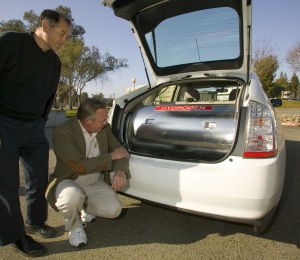Jun 4 2008
A cryogenic pressure vessel developed and installed in an experimental hybrid vehicle by a Lawrence Livermore National Laboratory research team can hold liquid hydrogen for six days without venting any of the fuel.
 Salvador Aceves (left) and Tim Ross check out the on-board hydrogen storage tank that powers a prototype hybrid vehicle. (Photos by Jacqueline McBride/LLNL)
Salvador Aceves (left) and Tim Ross check out the on-board hydrogen storage tank that powers a prototype hybrid vehicle. (Photos by Jacqueline McBride/LLNL)
Unlike conventional liquid hydrogen (LH2 tanks in prototype cars, the LLNL pressure vessel was parked for six days without venting evaporated hydrogen vapor.
The LLNL development has significantly increased the amount of time it takes to start releasing hydrogen during periods of long-term parking, as compared to today’s liquid hydrogen tanks capable of holding hydrogen for merely two to four days.
LH2 tanks hold super-cold liquid hydrogen at around -420 Fahrenheit. Like water boiling in a tea kettle, pressure builds as heat from the environment warms the hydrogen inside. Current automotive LH2 tanks must vent evaporated hydrogen vapor after being parked three to four days, even when using the best thermal insulation available (200 times less conductive than Styrofoam insulation).
In recent testing of its prototype hydrogen tank onboard a liquid hydrogen (LH2) powered hybrid, LLNL’s tank demonstrated a thermal endurance of six days and the potential for as much as 15 days, helping resolve a key challenge facing LH2 automobiles.
Today’s automotive LH2 tanks operate at low pressure (2-10 atmospheres). The LLNL cryogenic capable pressure vessel is much stronger, and can operate at hydrogen pressures of up to 350 atmospheres (similar to scuba tanks), holding the hydrogen even as the pressure increases due to heat transfer from the environment. This high-pressure capability also means that a vehicle’s thermal endurance improves as the tank is emptied, and is able to hold hydrogen fuel indefinitely when it is about one-third full.
Last year, the LLNL experimental hybrid vehicle demonstrated the longest driving distance on a single tank of hydrogen (650 miles). The recent thermal endurance experiments validate the key benefit of cryogenic pressure vessels: They deliver the high density of liquid hydrogen storage without the evaporative losses. These two advantages make LH2 vehicles far more practical in the search for a replacement to today’s gasoline-powered automobiles.
The Livermore work, sponsored by the Department of Energy’s (DOE’s) Office of Energy Efficiency and Renewable Energy, is part of DOE’s National Hydrogen Storage Project to demonstrate advanced hydrogen-storage materials and designs. The project is a component of President George W. Bush’s Hydrogen Fuel Initiative launched in 2003 as well as his DOE Advanced Energy Initiative of 2006.